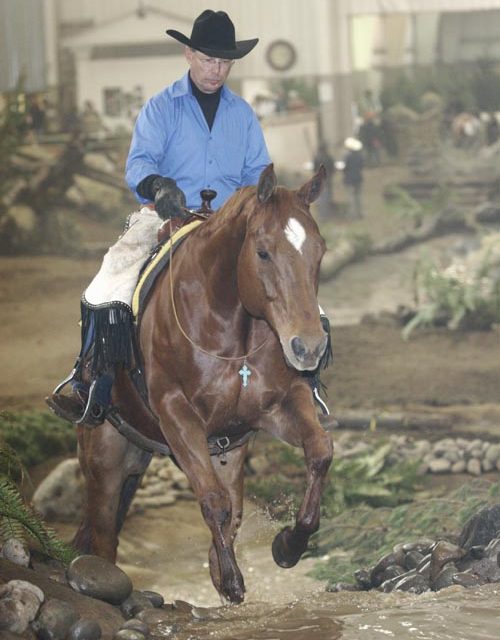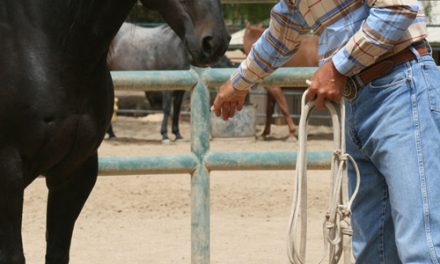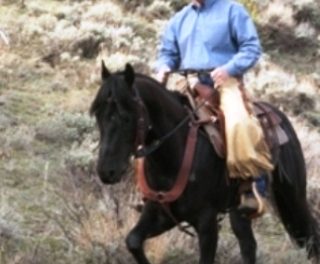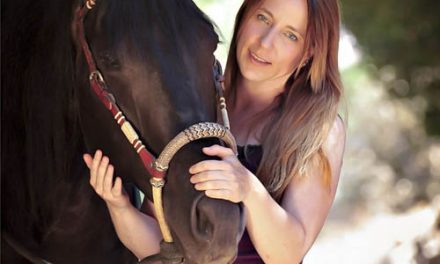When watching a well trained trail horse pick its way through difficult obstacles it might look easy. The horse seems bold and confident, as though there’s almost no effort on the rider’s part. We all want that perfect horse in order to achieve that perfect ride, whether on the trail or in the show ring. While great horses and riders make it look effortless, arriving at perfection is far from easy.
The single most important factor in achieving this is trust; the horse must trust the rider and vice versa. Trust results from proper training. We all talk about trust and how it’s so critical to a great ride. But I think few riders and trainers really understand the complexities of this trust, and it may not be what you think it is.
While giving a clinic in Palm City, Florida, I watched an interesting situation develop that illustrates this point. A rider became too tired to ride and then asked her friend and trainer to ride the horse for her. This was a gentle horse but not very trusting; it needed time to think before being pushed. Within minutes the horse was frantic. It quickly became such a danger to the rider that she had to dismount.
The explanation here is that the first rider’s confidence had grown over two days of careful coaching through obstacles that were difficult to navigate. The horse learned to trust that rider. The second rider did not trust the horse to do its job, and the horse sensed it. She tried to force the horse and in doing so she tightened up. To make matters worse, the rider didn’t understand what the horse was telling her. The horse interpreted this tightening up as fear or lack of leadership and its instinct took over. Trust in the rider was lost.
This example highlights how trust and instinct are woven tightly together in the horse’s mind. They can separate in an instant, as was the case with this horse and rider.
Just like with people, trust by a horse must be earned. To earn it you must step into the world of the horse and understand its rules of conduct. Theirs is not like our world at all. And if we treat them with our world values and principles they will not understand. Consequently, they will never learn to trust.
To understand their world, I have four simple rules for training. They are rules of their world, not ours, and are crucial to gaining their trust.
1) They have no equals. If you watch a herd of horses you soon appreciate that they kick, bite and play rough in establishing a clear pecking order. Their world is brutal, yet fair and clear.
2) They like to follow. However, they will only follow a clear and consistent leader. The herd’s leader is essentially an alpha mare. Eating is most favored next to the leader. If the leader is strong the herd feels secure; all is quiet and they follow the leader.
3) They try to please. They try to please those they regard above them or superior in the pecking order. If number one wants to eat where number two is, then number two must move. If number one wants to walk in the barn first then the herd waits for number one to walk in first, then they follow. If number one wants to cross the creek to the next pasture they all follow. They all try to please the leader and those they regard as superior.
4) Instinct drives all of it. Instinct isn’t right or wrong, nor good or bad; it just exists. It seems mysterious and frustrates us because it’s a different kind of intelligence.
With regard to the rules, if the horse’s instinct (rule 4) does not regard you as being superior (rule 1) then it will not follow you (rule 2) or try to please you (rule 3).
A horse’s instinct can pick up on our abilities, emotions and focus (or lack of it). Instinct will then dictate whether to trust or not trust. This basic brain function has kept this species alive longer than humans. It’s so refined that the blink of an eye, twitch of an ear, even your heart rhythm can mean the difference between trusting your leadership or not.
Great horsemen know these things and it’s fun to watch one at work. The thing that stands out immediately is that they do so very little yet get so much out of the horse. The little things you do carry great meaning. And when you’re clear and consistent, the horse’s instinct is to trust you as a leader. This is where the magic starts. You can direct that trust and instinct into a wonderful partnership in which even the most difficult obstacles can be navigated safely.
I enjoy teaching to navigate trail obstacles from the ground before I go on a trail ride. An arena with all the obstacles you’d find on a trail offers wonderful practice but not everyone has access to one.
If you don’t have an arena then you should train on the trail. Go on a trail ride with a few others where the sole purpose is to train for the demands of the trail. This will give you time to properly teach your horse and allow it time to think and process things while not under a time pressure. If your horse has a problem with water crossings then start from the ground and maybe plan to work on just that item. Less is more while training and subtlety is key. Also, stop on a good, positive note. Remember not to move your feet. The less you move your feet when teaching a horse from the ground, the faster it will learn. It’s important to remember the reason for this: instinct tells the horse that you’re a leader, and trust will naturally result.
 It’s surprising that so very little is known about natural instincts. And it’s even more surprising because even this small amount of knowledge we have is crucial to winning a horse’s trust. In my opinion, this knowledge is the number one secret to having a safe and fun trail ride for years to come.
It’s surprising that so very little is known about natural instincts. And it’s even more surprising because even this small amount of knowledge we have is crucial to winning a horse’s trust. In my opinion, this knowledge is the number one secret to having a safe and fun trail ride for years to come.
Mark Bolender is a two-time National Grand Champion in Extreme Trail and took away five championship titles at the National Mountain Trail Championship held November 4 – 7 at the Oregon Horse Center in Eugene. Bolender is from Silver Creek, Washington, and is a leader in the new sport of Extreme Trail, Mountain Trail, and Competitive Trail. The heart of Bolender’s training method is to understand the horse’s motivations and to use them to the rider’s advantage. When asked how he can get a horse to do the impossible, Bolender says, “Good horsemanship is not about domination, but having the horse volunteer for a partnership with you.” Bolender has designed and built Extreme Trail courses across the nation, including one in Ocala, Florida, for Lynn Palm, and has just been invited to build a course in Germany. All of them sponsor Extreme Trail clinics, including his own course at Bolender Horse Park in Silver Creek.
To book Mark Bolender for shows and expos, or to schedule an interview, contact Mark Bolender’s Promotions Director, Lee Sampson at 772-215-3989 (lee@UniqueHorsemanship.com). Also visit Mark’s new website at www.BolenderHorsePark.com for information, sportswear and videos. Join the Bolender Club and receive merchandise, bulletins and discounts… and become part of the Bolender Extreme Trail Community!






